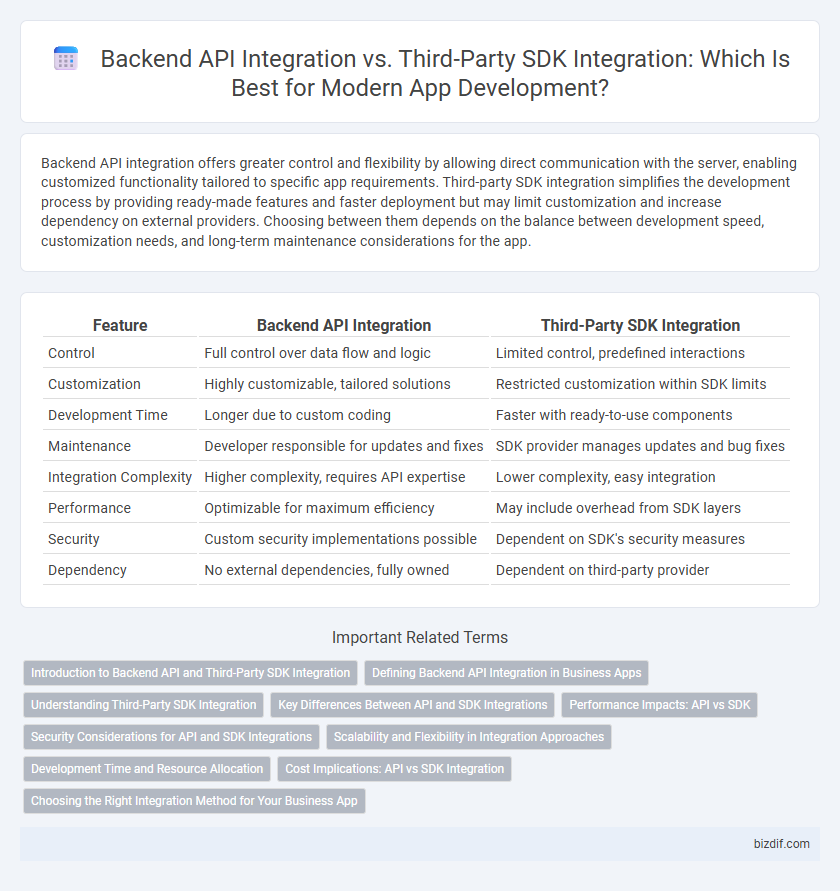Backend API integration offers greater control and flexibility by allowing direct communication with the server, enabling customized functionality tailored to specific app requirements. Third-party SDK integration simplifies the development process by providing ready-made features and faster deployment but may limit customization and increase dependency on external providers. Choosing between them depends on the balance between development speed, customization needs, and long-term maintenance considerations for the app.
Table of Comparison
| Feature | Backend API Integration | Third-Party SDK Integration |
|---|---|---|
| Control | Full control over data flow and logic | Limited control, predefined interactions |
| Customization | Highly customizable, tailored solutions | Restricted customization within SDK limits |
| Development Time | Longer due to custom coding | Faster with ready-to-use components |
| Maintenance | Developer responsible for updates and fixes | SDK provider manages updates and bug fixes |
| Integration Complexity | Higher complexity, requires API expertise | Lower complexity, easy integration |
| Performance | Optimizable for maximum efficiency | May include overhead from SDK layers |
| Security | Custom security implementations possible | Dependent on SDK's security measures |
| Dependency | No external dependencies, fully owned | Dependent on third-party provider |
Introduction to Backend API and Third-Party SDK Integration
Backend API integration involves connecting an app directly to server-side services via RESTful or GraphQL endpoints, enabling more control over data management and customization. Third-party SDK integration provides pre-built libraries that simplify adding features like payment processing or analytics, but often limits flexibility and increases dependency on external providers. Choosing between the two depends on project requirements, development time, and desired level of customization in the app development process.
Defining Backend API Integration in Business Apps
Backend API Integration in business apps involves connecting the app with server-side services through defined endpoints, enabling secure, scalable data exchange and custom functionality. This method allows developers full control over data handling, authentication, and business logic implementation tailored to specific organizational requirements. It is essential for maintaining flexibility and ensuring seamless communication between the app and core backend systems.
Understanding Third-Party SDK Integration
Third-party SDK integration streamlines app development by providing pre-built libraries and tools that enable faster implementation of complex functionalities such as payment processing, analytics, or social media sharing. This approach reduces the need for extensive backend API coding and ensures consistent updates and support from SDK providers, enhancing app performance and security. Leveraging well-documented SDKs facilitates seamless interoperability and accelerates time-to-market for mobile and web applications.
Key Differences Between API and SDK Integrations
Backend API integration enables direct communication between an app and a server through defined endpoints, allowing for tailored data exchange and control over backend processes. Third-party SDK integration bundles pre-built tools, libraries, and user interface components, offering streamlined implementation but less customization flexibility. APIs provide granular control with typically more development effort, whereas SDKs fast-track development by abstracting complexities but may impose constraints on app architecture.
Performance Impacts: API vs SDK
Backend API integration offers more control over data flow and typically results in lighter app performance due to direct server communication, minimizing resource consumption. Third-party SDK integration can introduce additional overhead, including larger app size and potential latency issues, because SDKs often run background processes and include extensive libraries. Choosing API integration often leads to faster response times and reduced battery usage, while SDKs may simplify development but at the cost of slower performance and increased memory demands.
Security Considerations for API and SDK Integrations
Backend API integration demands rigorous security measures such as encrypted data transmission, robust authentication protocols like OAuth, and strict access control to protect sensitive user information and prevent unauthorized access. Third-party SDK integration poses risks including exposure to unvetted code vulnerabilities, potential data leakage, and dependency on the SDK provider's security practices, necessitating thorough security audits and continuous monitoring. Secure integration strategies must prioritize minimizing attack surfaces by validating data inputs, employing proper token management, and regularly updating SDKs and APIs to patch known security flaws.
Scalability and Flexibility in Integration Approaches
Backend API integration offers greater scalability and flexibility by enabling custom data handling and seamless updates across distributed services, which supports evolving application requirements and volume growth. Third-party SDK integration simplifies initial development with pre-built functionalities but may limit scalability due to fixed features and dependency on the provider's update cycle. Choosing backend APIs provides control over performance optimization and scalability strategies, while SDKs expedite deployment but can constrain long-term customization and scaling options.
Development Time and Resource Allocation
Backend API integration demands more development time due to custom implementation and thorough testing, requiring skilled developers to manage server-side logic and data synchronization. Third-party SDK integration significantly reduces development time by providing pre-built functionalities, allowing faster deployment with less intensive coding and testing efforts. Resource allocation shifts accordingly, with backend API integration requiring dedicated backend developers and ongoing maintenance, whereas SDK integration often focuses on frontend developers and support for SDK updates.
Cost Implications: API vs SDK Integration
Backend API integration generally incurs lower upfront costs due to minimal licensing fees, but can require significant developer time for custom implementation and maintenance. Third-party SDK integration often involves higher initial expenses through licensing or subscription fees but reduces development time by providing pre-built functionalities and ongoing support. Evaluating the total cost of ownership, including development, maintenance, and scalability, is essential when choosing between backend API and third-party SDK integration.
Choosing the Right Integration Method for Your Business App
Backend API integration offers complete control and customization, allowing seamless data exchange tailored to specific business requirements, whereas third-party SDK integration speeds up development with pre-built functionalities but may limit flexibility. Evaluating your app's scalability, security needs, and long-term maintenance helps determine whether a custom API or an SDK better supports your business goals. Prioritizing integration methods based on performance demands, developer expertise, and integration complexity ensures efficient and sustainable app development.
Backend API Integration vs Third-Party SDK Integration Infographic

 bizdif.com
bizdif.com